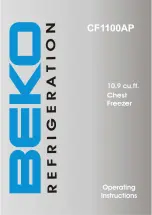
9 Care and maintenance
8.5
Defrosting food
▸ Do not defrost frozen food at room temperature or on the heating. Food defrosts
slowly in the refrigerator compartment. As a quick alternative, defrost in a microwave
or steamer.
▸ Do not refreeze food once defrosted! Only after being prepared (through cooking or
frying) can food be refrozen.
9
Care and maintenance
For the hygienic storage of food, the interior should always be kept clean.
Do not use any abrasive cleaning agents or scouring cloths to clean the appliance.
Take care not to press too hard when cleaning the plastic surfaces.
Do not use acidic or strongly alkaline cleaning agents on metal surfaces.
Risk of damage to the appliance.
9.1
Vegetable drawer and glass shelves
Condensation can form in the vegetable drawer and on the glass shelves, depending on
the kind and quantity of food being stored.
▸ Regularly wipe away any condensation with a dry
cloth.
9.2
Interior
▸ Surfaces that can come in contact with food and accessible drainage systems must
be cleaned regularly.
▸ Clean the interior periodically with a mild soapy solution and wipe completely dry.
9.3
Operating and display elements
▸ Clean the operating and display elements just with a slightly damp cloth.
9.4
Door seals
▸ Regularly check the door seals and
▸ if dirty clean using a soft brush and clean water. Wipe dry.
9.5
Defrosting
The fully automatic NoFrost system keeps the freezer compartment frost-free. The appli-
ance regularly defrosts automatically, rendering manual defrosting unnecessary.
9.6
When the appliance is not in use
▸ If the appliance is not to be used for an extended period of time, switch it off (see
▸ Empty and clean the appliance.
▸ Leave the refrigerator and freezer compartment doors open.
24













































